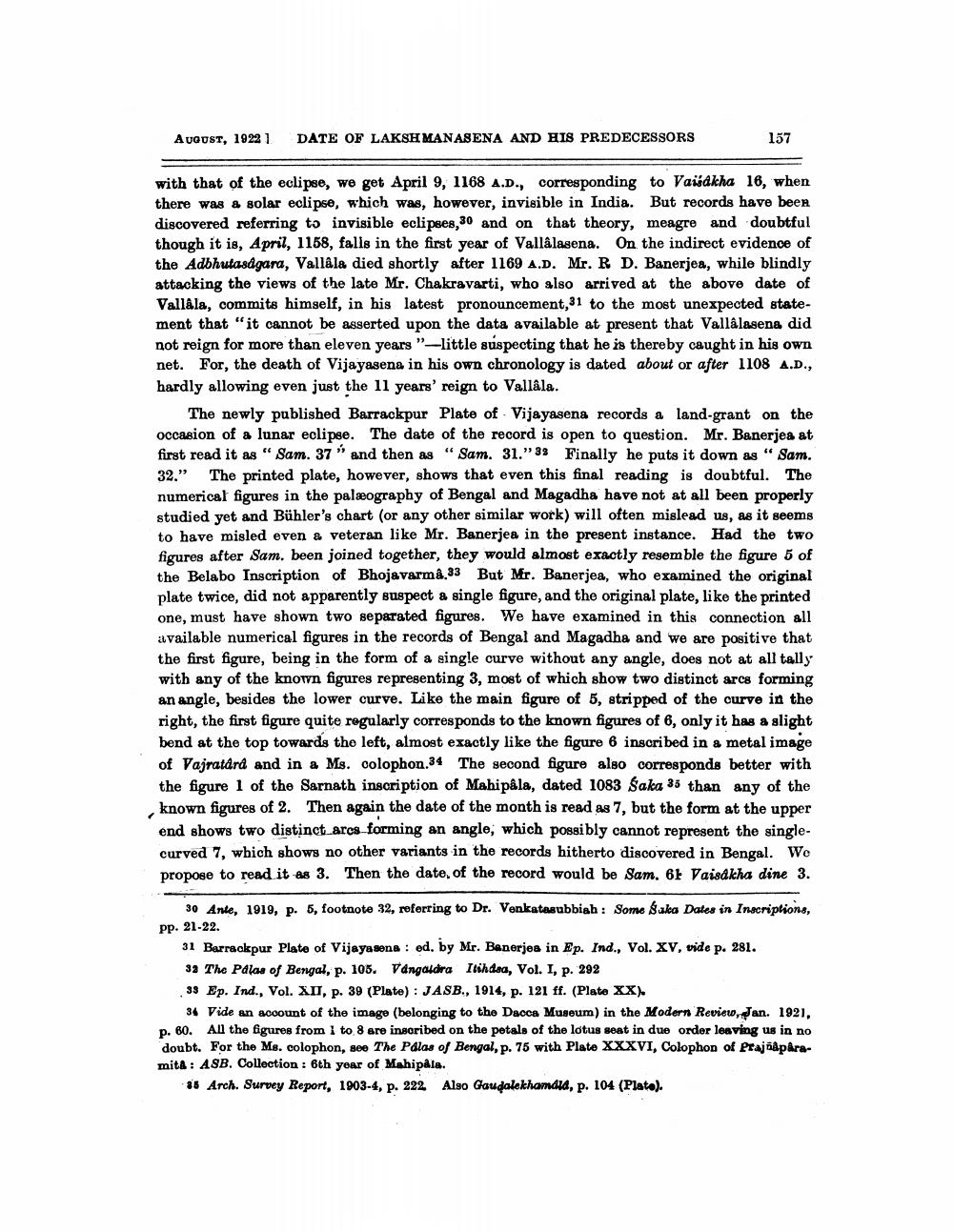________________
AUGUST, 19221
DATE OF LAKSH MANASENA AND HIS PREDECESSORS
157
with that of the eclipse, we get April 9, 1168 A.D., corresponding to Vaisakha 16, when there was a solar eclipse, which was, however, invisible in India. But records have been discovered referring to invisible eclipses 30 and on that theory, meagre and doubtful though it is, April, 1158, falls in the first year of Vallâlasena. On the indirect evidence of the Adbhutasdgara, Vallala died shortly after 1169 A.D. Mr. R D. Banerjee, while blindly attacking the views of the late Mr. Chakravarti, who also arrived at the above date of Vallala, commits himself, in his latest pronouncement,31 to the most unexpected statement that "it cannot be asserted upon the data available at present that Vallâlasena did not reign for more than eleven years"-little suspecting that he is thereby caught in his own net. For, the death of Vijayasena in his own chronology is dated about or after 1108 A.D., hardly allowing even just the 11 years' reign to Vallala.
The newly published Barrackpur Plate of Vijayasena records a land-grant on the occasion of a lunar eclipse. The date of the record is open to question. Mr. Banerjea at first read it as “ Sam. 37" and then as “Sam. 31." 32 Finally he puts it down as " Sam. 32." The printed plate, however, shows that even this final reading is doubtful. The numerical figures in the palæography of Bengal and Magadha have not at all been properly studied yet and Bühler's chart (or any other similar work) will often mislead us, as it seems to have misled even & veteran like Mr. Banerjea in the present instance. Had the two figures after Sam. been joined together, they would almost exactly resemble the figure 5 of the Belabo Inscription of Bhojavarmå.33 But Mr. Banerjea, who examined the original plate twice. did not apparently suspect a single figure, and the original plate, like the printed one, must have shown two separated figures. We have examined in this connection all available numerical figures in the records of Bengal and Magadha and we are positive that the first figure, being in the form of a single curve without any angle, does not at all tally with any of the known figures representing 3, most of which show two distinct arcs forming an angle, besides the lower curve. Like the main figure of 5, stripped of the curve in the right, the first figure quite regularly corresponds to the known figures of 6, only it has a slight bend at the top towards the left, almost exactly like the figure 6 inscribed in a metal image of Vajratard and in a Ms. colophon.34 The second figure also corresponds better with the figure 1 of the Sarnath inscription of Mahipala, dated 1083 Saka 35 than any of the known figures of 2. Then again the date of the month is read as 7, but the form at the upper end shows two distinct_arcs forming an angle, which possibly cannot represent the singlecurved 7, which shows no other variants in the records hitherto discovered in Bengal. Wo propose to read it as 3. Then the date of the record would be Sam. 6 Vaisakha dine 3.
30 Ante, 1919, p. 6, footnote 32, referring to Dr. Venkatasubbiah: Somo la Dates in Inscriptions, pp. 21-22.
31 Barrackpur Plate of Vijayasena : ed. by Mr. Benerjea in Ep. Ind., Vol. XV, vide p. 281. 32 The Palas of Bengal, p. 105. Vangaldra Itihdea, Vol. I, p. 292 33 Ep. Ind., Vol. XII, p. 39 (Plate) : JASB., 1914, p. 121 ff. (Plate XX).
34 Vide an account of the image (belonging to the Dacca Museum) in the Modern Review, Jan. 1921, p. 60. All the figures from 1 to 8 are inscribed on the petals of the lotus seat in due order leaving us in no doubt. For the Ms. colophon, see The Palas of Bengal, p. 75 with Plate XXXVI, Colophon of Prajña paramitA: ASB. Collection : 6th year of Mahipala.
36 Arch. Survey Report, 1903-4, p. 222 Also Gaudalokhamdia, p. 104 (Plato).




